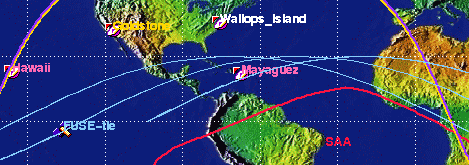

Mission Status Report #28 Star Date: January 3, 2000

A graphical view of the FUSE orbit track (light blue) for three orbits, projected on the earth. The red contour outlines the region where the South Atlantic Anomaly (SAA) affects on orbit operations. The double purple/yellow curve, running almost vertically through Hawaii, demarcates the orbital day/night boundary (day is on the yellow side), and several ground station positions are also indicated. As the earth turns "under" the FUSE orbit, the spacecraft goes through a sequence of orbits where the ground track intersects the SAA, and science operations are temporarily halted. (See discussion below.) (Click image to see expanded version.)
FUSE Flies Smoothly Through Y2K BoundaryWe are happy to report that the FUSE project has transitioned smoothly through the Y2K boundary and all systems are A-OK! As a precaution, we terminated observations briefly during the transition period and left the satellite in a benign state (guiding on stars) during the transition, but no problems occurred and observations picked up again shortly after the transition. Thanks to all on the team who, over the last several months, have worked to ensure that this transition was smooth. We didn't expect to have any problems, and we didn't have any! Actually, our biggest difficulty right now is the South Atlantic Anomaly (SAA), a region of space over the south Atlantic Ocean where the Van Allen radiation belts dip lower than elsewhere around the earth. FUSE can continue guiding on guide stars through these periods, but we do not operate the FUV detectors (and hence do not acquire science data) during the times when the satellite passes through this part of the orbit. (See graphic above.) As the earth rotates under the FUSE orbit, about 8 or 9 orbits (out of 14 orbits per day) are affected by the SAA. Usually this is not a big problem, but there are periods of two to three weeks every 60 days where the SAA adversely affects operations by wiping out the orbital night and near-night viewing periods. Since spacecraft constraints force us to mostly observe objects with orbital night visibility, the efficiency of operations drops way down during these times, and it takes special care on the part of mission planning to find targets with the "right" visibility to allow FUSE to maintain guidance. (In other words, we have to work harder and get less in return!) Such is life in orbit. We are in one of these periods now and for the next couple of weeks. Many FUSE team members will be travelling to Atlanta next week for the American Astronomical Society meeting, where over two dozen presentations will be made showcasing FUSE data. We should have much more to say about FUSE "science" results after that time! And now for a new year's present: Want to see a few example FUSE spectra? CLICK HERE! Reported by: Bill Blair, Chief of Mission Planning
|